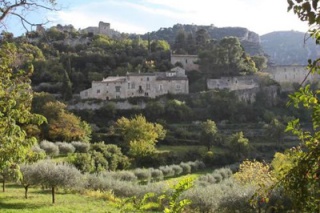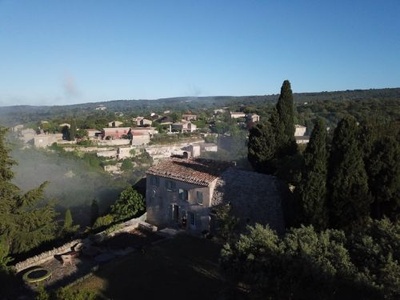Contact us
Send an email
Village of Vaucluse: Oppede
Oppede, gate of the Luberon between plain and mountain

The territory of Oppède is in a historical and human context. It is limited to the north by the old domitian road which runs along the Calavon and to the south by the mountain of the Luberon.
Oppède to the peculiarity of being composed of two villages that have succeeded each other as chief town in the course of time: Oppède le Vieux and in the plain, the hamlet of Poulivets. During the 20th century, when Oppède le Vieux was ruined, les Poulivets, the new village was built in the center of the valley. Today the vine dominates the agricultural landscape, accompanied by some cereals, market gardening and orchards. The economic activity of Oppède is also the exploitation of stone quarries of international renown, as well as businesses, craftsmen, local shops and establishments related to tourism.
There are few witnesses of the distant past. Some traces of the Roman occupation are visible on the expanse of the commune. Although some remains date back to the Middle Ages, most of Oppède's heritage was built in the plain from the 16th century. The Saint Joseph's Oratory and four washhouses have been restored, the municipality being very attentive to safeguarding the public heritage. La Collégiale: Alone on the crest of relief, Our Lady of Alidon (from the Latin Dolidus: painful) has passed through the centuries. The date of construction of the early church (10th or 11th century) is unknown. In 1546, on the orders of Maynier d'Oppède, the building was restored and erected as a collegiate church by the Vice-Legate of Pope Paul III. Abandoned at the end of the 19th century, this collegiate church and the whole of the Old Village are currently the object of a program of enhancement by the Municipality in partnership with the Regional Natural Park of the Luberon. It is rare to find in Provence an edifice essentially of the XVIth century remained in the state since that time.
The Old Village: In the 16th century, the fief of the ancient popes of Avignon became a barony, the second baron, Maynier d'Oppède, was commissioned to execute the fatal arrest of the parliament of Aix against the Vaudois. If in the 16th and 17th centuries Oppède becomes a village similar to its neighbors, the process of "déperchement" is confirmed. The castle is abandoned in the seventeenth century as well as the top of the piton. The residential areas will therefore move and, in the 19th century, construction activity takes place in the plain. In 1909 the town hall is transferred to the hamlet of Les Poulivets. In the 20th century the Old Village was ruined and the vegetation invaded. Its population is reduced to a few households. It was only after the War of 39/45 that some houses began to be reinvested and restored.
The Castle: the ruins of the Castle crown the piton. The medieval building was enriched in the 16th and 17th centuries. It offers us its magical ruins whose secrets are revealed sparingly by vegetation.
Sotheby's International Realty : Your specialist in luxury real estate in the Luberon and in Provence
Oppède to the peculiarity of being composed of two villages that have succeeded each other as chief town in the course of time: Oppède le Vieux and in the plain, the hamlet of Poulivets. During the 20th century, when Oppède le Vieux was ruined, les Poulivets, the new village was built in the center of the valley. Today the vine dominates the agricultural landscape, accompanied by some cereals, market gardening and orchards. The economic activity of Oppède is also the exploitation of stone quarries of international renown, as well as businesses, craftsmen, local shops and establishments related to tourism.
There are few witnesses of the distant past. Some traces of the Roman occupation are visible on the expanse of the commune. Although some remains date back to the Middle Ages, most of Oppède's heritage was built in the plain from the 16th century. The Saint Joseph's Oratory and four washhouses have been restored, the municipality being very attentive to safeguarding the public heritage. La Collégiale: Alone on the crest of relief, Our Lady of Alidon (from the Latin Dolidus: painful) has passed through the centuries. The date of construction of the early church (10th or 11th century) is unknown. In 1546, on the orders of Maynier d'Oppède, the building was restored and erected as a collegiate church by the Vice-Legate of Pope Paul III. Abandoned at the end of the 19th century, this collegiate church and the whole of the Old Village are currently the object of a program of enhancement by the Municipality in partnership with the Regional Natural Park of the Luberon. It is rare to find in Provence an edifice essentially of the XVIth century remained in the state since that time.
The Old Village: In the 16th century, the fief of the ancient popes of Avignon became a barony, the second baron, Maynier d'Oppède, was commissioned to execute the fatal arrest of the parliament of Aix against the Vaudois. If in the 16th and 17th centuries Oppède becomes a village similar to its neighbors, the process of "déperchement" is confirmed. The castle is abandoned in the seventeenth century as well as the top of the piton. The residential areas will therefore move and, in the 19th century, construction activity takes place in the plain. In 1909 the town hall is transferred to the hamlet of Les Poulivets. In the 20th century the Old Village was ruined and the vegetation invaded. Its population is reduced to a few households. It was only after the War of 39/45 that some houses began to be reinvested and restored.
The Castle: the ruins of the Castle crown the piton. The medieval building was enriched in the 16th and 17th centuries. It offers us its magical ruins whose secrets are revealed sparingly by vegetation.
Sotheby's International Realty : Your specialist in luxury real estate in the Luberon and in Provence
The latest news





